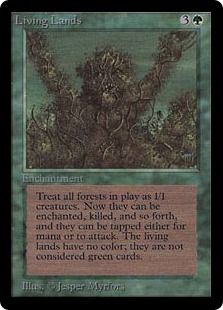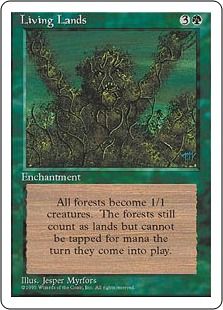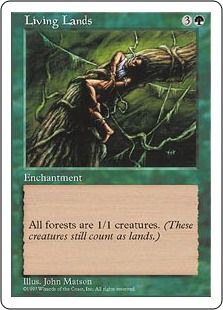|
Bugsy posted:I dont know specifically about Lovecraft, but Whip-poor-wills were considered Psychopomps which kind of relates to the awkwardly templated magic card. Well that explains the ability then! I actually didn't know that which is kind of interesting. Still, it doesn't fly, so there.
|
|
|
|

|
| # ? Apr 28, 2024 11:18 |
|
Are we on to Magic now? I don't remember a lot of the cool things since I haven't played in a while but here, let's see how the rules on cards have changed over the years! These are all the same card, the rules text all means the exact same thing. Living Lands Alpha, Beta, and Unlimited  quote:Treat all forests in play as 1/1 creatures. Now they can be enchanted, killed, and so forth, and they can be tapped either for mana or to attack. The living lands have no color; they are not considered green cards. Revised  quote:Treat all forests in play as 1/1 creatures. Now they can be enchanted, killed, and so forth, and they can be tapped either for mana or to attack. 4th  quote:All forests become 1/1 creatures. The forests still count as lands but cannot be tapped for mana the turn they come into play. 5th  quote:All forests are 1/1 creatures. (These creatures still count as lands.) 6th  quote:All forests are 1/1 creatures that are still lands.
|
|
|
|
|
yaoi prophet posted:if there's any place these things belong, it's here. OK, here we go. To play spells in Magic, you usually have to pay for them with mana, generated by using some kind of mana ability. Island has a mana ability, Black Lotus has a mana ability, Vault Skirge has a mana ability. In 1997 Dave Mills was disqualified from the finals of Pro Tour Los Angeles for playing spells and then using mana abilities, a common practice. This led to history's only Magic riot, as a group of neckbeards stormed the stage during the award ceremony and demanded justice for Mills. The judges relented and gave Mills a second-place prize, also changing the rules so that it became legal to activate a mana ability while paying costs. Now the rules say that a player can't do anything in response to a mana ability, so nothing can disrupt a mana ability once started. This brings us to Caged Sun, a card that doesn't work. All mana abilities are activated (pay [cost]: do [effect]) except for Caged Sun, which is triggered (when [trigger], then [effect]). A ruling says that Caged Sun has a mana ability anyway, otherwise this would create some awkwardness when playing spells with Caged Sun in play. So Caged Sun has a mana ability that adds mana to your mana pool whenever a land adds mana to your mana pool. The rules break down when Caged Sun itself becomes a land, which we accomplish by playing a few cards. March of the Machines makes all artifacts into creatures, so Caged Sun is an artifact creature. Xenograft makes all your creatures a chosen creature type, so Caged Sun can become an artifact creature - Saproling. Life and Limb makes all Saprolings into lands, so Caged Sun is now an "Artifact Creature Land - Saproling Forest". Caged Sun now has a mana ability that effectively reads "Whenever Caged Sun adds mana to your mana pool, add one mana of that colour to your mana pool." Neither player is allowed to do anything until this loop completes, so the players sit there helplessly as the game repeats itself. At this point the game is officially a draw. Caged Sun is a fun example of the problems caused by type changing effects, and also the dangers of infinite loops. An infamous type change problem comes from Humility and Opalescence, which causes Humility to lose the ability that causes it to lose all abilities. Another infinite loop involves three copies of Oblivion Ring with no other targets. With one ring exiling another, the third ring comes into play and exiles one of them. The new ring exiles another, and if there's nothing else in play they loop around forever. One of the game's best players created this loop in an online tournament just to see what would happen - video. There are other ways to break the rules of Magic for fun and (not much) profit, which I'll post about later because I'm busy.
|
|
|
|
Disregard!
|
|
|
|
Chamale posted:An infamous type change problem comes from Humility and Opalescence, which causes Humility to lose the ability that causes it to lose all abilities. This doesn't cause any problem at all in the rules now, due to layering of continuous effects. The Opalescence makes Humility a 4/4 creature, then Humility applies to remove its own ability. Because Humility's ability has already begun to apply, though, it also makes itself a 1/1. The same thing happens if you have two Opalescences, so they too become creatures - everything becomes a creature, loses its abilities, then becomes either 4/4 or 1/1 depending on whether the last of the three enchantments to come into play was Opalescence or Humility. However, if you add a Glorious Anthem to the mix the Anthem won't do anything at all because its ability is removed before any part of it applies. Interesting that someone brought up Whippoorwill, because that card inspired an entire casual format called Kangaroo Court Magic. In KCM, players could challenge the rules if they didn't make logical sense and their opponent would have a chance to rebut. A neutral third party would act as judge. So you might have arguments over whether Headless Horseman can be equipped with Helm of Kaldra or if Shu Soldier-Farmers are affected by Swords to Plowshares because they use plowshares as weapons.
|
|
|
|
yaoi prophet posted:if there's any place these things belong, it's here. Activate a Jade Statue. Target it with the second ability of a Neurok Transmuter. Pass through combat. You now have a card in play with no card type. Nightfall Predator can fight itself. At one point, you could use Cytoshape to turn a Duplicant into a Death-Mask Duplicant, remove some creatures, and when it turned back into a Duplicant, it would have multiple values for power and toughness, which is one of the few situations that isn't covered by the rules. Eventually they changed the rules so that Duplicant's second ability refers only to the card removed by its first ability. GottaPayDaTrollToll fucked around with this message at 01:48 on Feb 26, 2013 |
|
|
|
Magic's innermost core rules have been changed quite a few times over the years, as the designers and developers get a better idea for: A.) What works B.) What's fun C.) What's understandable However, this means that some rules get left in the dust, causing entire swaths of cards to no longer function the way they used to. For example, a recent major change was the removal of an entire concept: Mana burn. If you somehow got a hold of TOO MUCH mana, at the end of your turn, it would literally "burn" its way out of your body, doing an equal amount of damage to the total excess. This prevented certain abusive combos and tricks from going haywire, punished players for making resources they never intended to use, and allowed players in (most) situations a suicidal out from a game they did not want to concede. Of course, it also had downsides. There is a card (based one one of my favorite characters) that functionally kills a player if they are at precisely ten life-- Not any higher or lower. (The starting life total is 20, and another card related to said character halves a player's life.) You can only cast it on your own turn, however, so if your opponent sees it coming, they can just mana burn themselves for 1. A single point of life doesn't make much difference, but they just dodged an instant-kill at no real cost. Mana burn was removed in 2009 with the 10th Edition rules changes, and with it, several cards were made worse, and some were made better. But one thing that many people forget is how the fix has completely removed some functional actions from the game. See, the new rule is that your unused mana simply "empties" at the end of every single step and phase of the turn. So now every ability and card that produces mana in your Upkeep (a very early portion of the turn primarily used to check for certain abilities) is functionally limited, since its only use is to cast the tiny fraction of your cards that can be used during the Upkeep. (Formerly, you could carry mana over from the Upkeep to the Draw, which mattered for a fairly large slice of cards and effects.) And producing mana in combat? Sorry, but you're going to lose it after every STEP-- So mana produced while you are Declaring Attackers is gone the split-second later when your enemy Declares Blockers. It's an elegant solution that removes both the problems of mana burn and some memory issues with 'floating' mana, but there are a lot of older cards that are now just a bit more gimped. Ariamaki fucked around with this message at 03:56 on Feb 26, 2013 |
|
|
|
Ariamaki posted:See, the new rule is that your unused mana simply "empties" at the end of every single step and phase of the turn. Mana emptied at the end of the upkeep anyways.
|
|
|
|
WhitemageofDOOM posted:Mana emptied at the end of the upkeep anyways. You're half-right-- It emptied at the end of that entire -phase-, which meant you formerly could use Upkeep mana (Braid of Fire, for example) in the Draw step. Well, the point about combat tricks still stands. 
Ariamaki fucked around with this message at 03:57 on Feb 26, 2013 |
|
|
|
Ariamaki posted:You're half-right-- It emptied at the end of that entire -phase-, which meant you formerly could use Upkeep mana (Braid of Fire, for example) in the Draw step. 1) Draw phase 2) Not like i wanted to risk braid of fire burn vs. hoping i draw a card to empty it. Braid of fire got waaaaay better. quote:Well, the point about combat tricks still stands. Combat is still a thing yeah.
|
|
|
|
I like the stuff about individual Magic cards, keep them coming! My wheelhouse is still on the very complicated combinations, so I'll keep them coming. Korlash, Heir to Blackblade and other "Grandeur" cards has an ability that involves discarding more copies of cards with the same name. However, it's possible to discard Korlash to himself. With Suppression Field in play, his ability costs mana and a discard to activate. Activate a Words of Wind, then announce Korlash's ability. Use a Chromatic Sphere's mana ability to pay for Korlash - remember, players can't respond to mana abilities, and they can be activated while paying for costs. While paying for Korlash's ability (which costs "2, discard a card named Korlash, Heir to Blackblade), activate Chromatic Sphere, replace the draw by returning Korlash to your hand, and then discard the card you just returned to your hand to finish paying the cost. It's possible to temporarily dip below 0 life while using mana abilities to pay for something. For example, with an active Words of Worship, you can activate Tarnished Citadel and Chromatic Sphere to pay for a spell - perhaps Barren Glory - and temporarily go below 0 life until the Words replaces the draw to put you back into safe territory. A player doesn't lose if they're only dead in between the checks on state-based effects. Because of the nature of mana abilities, Chromatic Sphere leads to many odd situations. If I control one plus a way to feed it mana, a Thought Lash, and a Laboratory Maniac, I can win the game without ever giving my opponent a chance to respond. Unlike the other comboes listed, this one is good enough that I've won small Legacy tournaments with it, and I've had no end of entertaining judge calls. Chamale fucked around with this message at 05:52 on Feb 26, 2013 |
|
|
|
Would it be possible in Magic to have a deck entirely made up of combinations like that, with no monsters or anything, and have it be effective at all? It seems like the biggest
|
|
|
|
Plank posted:Would it be possible in Magic to have a deck entirely made up of combinations like that, with no monsters or anything, and have it be effective at all? It seems like the biggest Decks like that are actually fairly common in some formats. During the infamous "Combo Winter," they were overwhelmingly dominant.
|
|
|
|
So to give this thread a Magic break, I want to bring up my favorite mini-game Malifaux. It's a strategy game with a handful of units instead of dozens of cannon fodder. The cheapest model in the game still finds a use in really good crews and there's no such thing as a "take all comers" list. Anyway, this is Dr. Douglas McMourning. He works for the Guild, but really is a Resurrectionist who believe the dead of Malifaux hold more secrets than any tome.  Why doesn't anyone visit me when doing autopsies in the morgue He is a not a caster who messes around with skeletons. He uses scalpels to slice parts off of enemies (or his own crew for that matter) and uses it to implant them into other people, give himself the ability to have an extra action, or just make flesh constructs. The problem is that even though he enables everyone in game to start dropping corpse counters when they die (which he can slice up into 2 body parts) he can't use them if they are lying on the ground and he's not there to pick them up. Graverobbers, and only graverobbers, pick corpses up if something dies in base-to-base to them OR if they walk across a corpse counter. That last one is important. This is where the the used-to-be buggy Push rules could be taken advantage of. Push directly toward/away, fine. You make a bee-line toward/away from the thing that is causing the push. If you run into a wall, start climbing bub. Push towards/away means that you can make detours as long as it gets you farther/closer than any other route (too bad that bridge is so far away, now cross that lava river). Now the problem Push. Push into base-to-base. Here's one of McMourning's awesome abilities 0) Scalpel Slinginí [Surgical Implements]: Make a Rg 6 Surgical Implements Strike. If the target is wounded by this attack, push this model into base contact with the target. This is considered a melee attack. No difficulties right? Lift the guy up, and put it next to his target. McMourning loves the job of slicing so much, he just FLIES into his next target and digs in. According to the rules, though, a Push base-to-base means that the only requirement for McMourning to have at the end of the Push it to be next to a model. Now a short series of bad MSPaint to show what could legally happen on the board.     The company threw out some general clarifications but pushes into base-to-base contact was changed in a way that made sense, pick that guy being pushed up and put him down next to the thing he is supposed to be next to. Pros: If there is lava between you and target, you can avoid taking damage. Cons: If there is something you can pick up between you and the target, you can't picked it up. No one actually abused this bug around our area, but it was possible due to the rules.
|
|
|
|
Plank posted:Would it be possible in Magic to have a deck entirely made up of combinations like that, with no monsters or anything, and have it be effective at all? It seems like the biggest Absolutely. In the deck building thread we've come up with a deck that uses creatures, in a sense, to summon a 60/60 giant death creature on the first turn, and there are decks built around Tendrils of Agony that win games without ever playing a creature. One popular deck in Modern (a format restricted to the cards made since 2003) has only one win condition in it, a single Pyrite Spellbomb, and once it gets going it can return it from the discard pile to play any number of times to kill the opponent. A deck in Legacy has no win condition at all, but uses Cunning Wish to bring in a Blue Sun's Zenith from outside the game. I recall reading a great quote:I cast Burning Wish, the ninth spell this turn, and moved to bring out the game-winning Tendrils of Agony. My opponent pouted, "don't you have any decks that play creatures?" I paused, smiled, and reached for my copy of Empty the Warrens.
|
|
|
|
This will not be as long or as funny as some other entries, but Exalted and some other Storyteller games have a prime example of how the attribute/ability divide (ability score/skill in D&D type games) can get weird. Like most games with attributes, one of the attributes is Strength. Strength determines how large of a weapon you can wield, helps determine how much damage you do when you hit with a weapon, and the description says it determines how much you can lift, with a STR 1 dude barely able to lift 40 pounds and a STR 5 dude able to casually lift 400 pounds. This seems pretty reasonable so far. However, there are abilities in addition to attributes, and one of them is aAhletics, which determines your general level of athletic ability. It helps determine how fast you can run and swim as well as...also determining how much you can lift. This isn't completely silly yet, no, but there's clearly a weird degree of overlap. The game solves this by creating a "Feats of Strength" chart where your Strength and your Athletics are added together to determine how much you can lift and how strong you exactly are. This isn't totally weird on its own either. It gets a little weirder when you consider a character with low strength but high athletics. If I make a character with Strength 1 and Athletics 5, they are stronger in terms of lifting. Also, according to the Feats of Strength chart, the character with Athletics but low Strength can punch through heftier walls and doors than the character with high Strength. This still sort of makes sense, because, hey, training can overcome a low natural aptitude. Finally, it starts to seem completely dumb when you have a character who can lift more than twice as much as another character (the STR 1 and Athletics 5 guy) but can't use the big fuckoff sword or deal as much damage in combat as the guy with STR 3. It sort of makes sense from a game balance perspective, because points of Strength are more expensive to buy, so they should have a bigger in-game benefit, but because of the weird granularity of the Feats of Strength chart, there is a complete disconnect between how strong your character is and how much benefit you get from being Strong in terms of weapon-use or hitting people. Maybe this is dumb and groggy, but it always stuck out as weird to me.
|
|
|
|
Summary, ability scores are stupid.
|
|
|
|
MiltonSlavemasta posted:Maybe this is dumb and groggy, but it always stuck out as weird to me. White Wolf's feat of strength charts have always been stupid, and they can implode under the lightest amount of critical thought. Including "you can punch through X" on the charts was one of the worst things to do, especially in Exalted 2E which had rules for combat attacks against objects anyway (those rules were also loving dumb). Really, you should immediately dismiss the chart when you get to the part about how a yeddim doesn't even weigh a ton.
|
|
|
|
White Wolf did come up with so called Specialty Skills in Vampire that had the worst scaling of anything in that game, it went something like: 1:Reasonable 2:Reasonable 3:Reasonable 4:Extremely Good 5: MOTHERFUCKING WIZARD MAGIC For instance, four dots in Falconry made you an extremely good Falconer. Five dots made you be able to SPEAK TELEPATHICALLY WITH YOUR PET BIRD (and also see through its eyes!). Whatever the scavenging skill was let you get an apartment overlooking central park for free! The only one that was even close to OK was Gambling. Also Athletics has always been a problem in those games. I first knew this when I played in a game where my character who was a David Blane/Chris Angel style professional magician had high athletics and this also happened to make him an amazing archer and triathlete.
|
|
|
|
WhitemageofDOOM posted:1) Draw phase Actually, while it's not a weird rules thing in and of itself, this is a good thing to point out: You're (not directly, although that would be funny) one of the main reasons they got rid of mana burn. Emphasis mine, quotes otherwise unchanged: Aaron Forsythe, Rules Manager of Magic posted:Many players can't clearly distinguish between phases and steps. The fact that mana remains in pools from step to step but not phase to phase is arbitrary. The concept of floating mana from step to step is hard to understand. Aaron Forsythe, Rules Manager of Magic posted:Mana pools now empty at the end of each step and phase, which means mana can no longer be floated from the upkeep to the draw step, nor from the declare attackers step to the declare blockers step of combat. See, the entire beginning of your turn-- That lovely sequence of "Untap, Upkeep, Draw" that it usually takes a while for a new player to pick up? For reasons partially clear only to the rules creators and managers, those are all one single phase, called the Beginning Phase. There is not now, and has never been, a Draw Phase. It's easy to forget, and even easier to get confused about. Confusion over this kind of thing is actually a bigger portion of why the rules for mana burn were removed than the actual damage issues. And speaking of damage issues, let's talk about Lifelink for a moment: I promise I'll dredge up some non-Magic stuff for future posts, but I wanted to stay on-topic with myself.  Lifelink is a static ability a creature can have in the rules that is pretty intuitive: When this creature harms things, you get the life they functionally "stole". However, there are quite a few older cards that have an ability that is almost, but not quite, the same. Compare and contrast: Whenever enchanted creature deals damage, you gain that much life. VERSUS Damage dealt by the creature also causes (its controller) to gain that much life The bottom one is the current reminder text for Lifelink, the top is the slightly-different ability from cards like the ever-so-awesome Armadillo Cloak.  So, what's the difference, exactly? Why not just keyword them both to the same abiity? Well: 1- They don't stack with themselves, but DO stack with each other. 2- If I put an Armadillo Cloak on your creature, -I- get the life when it hits me. 3- If I were to simultaneously receive enough damage to kill me, but also gain enough Lifelink life to survive (a common combat situation), I would, in fact, survive- As a static effect, Lifelink happens simultaneously with the damage that caused it. Armadillo Cloak's ability triggers too late to save me, as the game will check my life between damage and the Cloak going off.
|
|
|
|
Yeah it is not so much a problem with, say, Strength (still a stupid stat to have on its own in a 'storyteller' system) and more about having godly skills. Due to how Skill Specializations work in nWoD (They just give you a small bonus to some uses of a skill) it is possible to have some Very Silly Things happen. To give you an example, the world's most amazing Cook (Specialization of the Crafts skill) is also an incredible Carpenter and one of the best Demolitions specialists around the globe. Because of the awful way character creation and XP work in that system it is much more likely to have the above example happen than to have, say, an actual police demolitions expert who doesn't suck - Having spent a bunch of their starting points on combat related things, they will never catch up to the cook's raw Crafts prowess.
|
|
|
|
In D&D 3e, it's easier to learn how to shoot a magic seizure rainbow from your fingertips than it is to learn how to attack while also defending yourself. The seizure rainbow in question is Color Spray. In order to cast any spell, you only need to be able to cast spells (i.e. a Wizard or Sorcerer) and you must have a minimum set amount in an ability score, in this case 11 Intelligence if you're a wizard. To attack while defending yourself requires that you know the Combat Expertise feat. Feats are abilities which anyone can theoretically take but in practice are mostly poo poo or limited to just a subset of classes. And in order to learn this fairly basic combat concept, you need to have an Intelligence score of 13. "But wait", might someone say (and in my case actually has). "Surely it's harder to learn how to be a wizard than it is to pick up a single combat trick?" Nope, not at all. Not only do the rules specifically call out the situation of taking a single level of wizard by stating that it's assumed you've been studying in the background, but you also get more levels in classes than you get feats over your career. So not only is it harder to learn Combat Expertise, it takes up a resource which is more limited than character levels. In fact, you get more useful things to do as a fighting type character by taking one level in Sorcerer or Wizard than by taking any number of feats. With one level of either class, you can get access to abilities like magical unencumbering armor, A shield you don't have to hold and which protects you from magic attacks, the ability to endure any hostile environment, the power to grow huge, a momentary but extremely fast burst of speed, falling safely from any height and jumping. Most of these abilities and powers will never be available to your character through feats ever (because no hero ever leaped a tall building or endured a little heat or went faster when things were desperate according to D&D's design logic), but a single level of wizard will give you the chance to learn all of them plus more. The less limited resource of character levels thus grant you more unique potential abilities than your feats - which are nothing but abilities - can ever give you. You might have to eat a slight chance that the spells won't work due to the armor you choose to wear, but since most feats are also not guaranteed to work it's a fair trade - and, as it turns out, that failure chance is really easy to mitigate anyway. There's even a type of armor material designed for it called "mithral" due to D&D's amazing attitude towards originality and copyright. Rulebook Heavily fucked around with this message at 12:48 on Feb 26, 2013 |
|
|
|
Quick question of intent: I have some ideas for future posts, but they're not for RPGs. Or tabletop games at all, actually. Would it be alright to stretch the OP intent to include extremely weird game design interactions / funky rulesets, for example, in video games? Because my inner designer has a major bone to pick with certain modern shooters...
|
|
|
|
Ariamaki posted:Quick question of intent: No, probably not. You should start a thread in Games for that.
|
|
|
|
That's more of a Games thread than a Tradgames thread yeah. Feel free to steal the idea, though.
|
|
|
|
Let's sparkle a little bit of variety into this thread outside of RPGs and Magic. There is a board game named Panic Station that is basically trying to be John Carpenter's The Thing as a game. It's a 4-6 player game in which one player is secretly a host to a bunch of alien parasites. At the beginning of the game, each player receives a loyalty card claiming which side they are on. The winning conditions to the game are as follows: If you are human, you must play 3 Gas Can cards inside the alien hive randomly located in the tiles representing the game's modular map. If you are infected, you must either (A) infect all the humans, (B) infect all but 1 human and neither he nor the items deck have any gas cans, or (C) kill all non-androids belonging to all players. Simple enough, right? Except nearly every one of these scenarios is horribly broken. In the case of (A), being the last human to get infected is the losing condition (in the current version. the original version of the game didn't have this rule lmao), because otherwise all the infected players would win which at that point includes literally every player. So, rules as written, the easiest way to avoid losing under these circumstances is to get yourself purposely infected as quickly as possible. It should be noted that for the infected player, secrecy is almost a moot point, because players in the same room have to run an infection chance (so no human players want to risk it) and there are 4 exits from the starting room, making it impossible for an infected player to subtly "bump" into a human player in a 4-player game. So either everybody goes in separate directions because it's the optimal human (and much harder unless you do exactly this) playstyle, or everybody rushes into a huge pack because it's the optimal alien (and easier) playstyle. Okay, so say you forego attempting to actually achieve the game's objectives as declared in the rulebook (playing it more like an RPG than a game with, you know, loving victory conditions), alien victory condition (B) involves one side possibly achieving a win condition without ever knowing it. Since people are likely not being very forward about their infections, it's possible to not ever know how many players are infected through normal play. You have to run a heat scan of the base to trigger this condition, proving how many players are infected, but even that doesn't include information of where the gas can cards may be (especially since gas can cards are something you want to keep hidden from the opposing team). It's not uncommon for games to run several turns longer than necessary because the alien side doesn't actually know they won 15 minutes ago. So, how did the designers address the issue of the rules not encouraging people to play the game in a thematically appropriate way? Well, the first thing they did was try to change it so that only the Host player wins when the infected team wins. Now, instead of rushing to attempt to get infected, people just gave up playing altogether because they already lost and nothing could change that. They then redacted that and recommended that players use a scoring system and play sets of games. Winning as a human is 2 points, winning as host is 2, winning as infected is 1. First player to 5 points wins. Except the average play time for a game of Panic Station is 45 minutes. Broken Loose fucked around with this message at 14:21 on Feb 26, 2013 |
|
|
|
CCGs are kosher? Awesome. There's a Cthulhu faction event card called Deep One Assault that lets you pay X to destroy any Character or Support card of cost X or lower. Support cards are usually things like Items, Locations etc, so it makes sense that a bunch of angry deep ones can smash them into bits to remove them from play. But that's boring! Why not use Deep Ones to: Cure disease? Heal wounds? Perform a little impromptu genetic engineering? But wait, there's more! You can: Enforce prohibition! Cut through academic red tape! Remedy decades of poor farming practices! You a nerd? Not a problem! Deep One assault has you covered! It can: Fix your glasses! Ruin a jock's life! Cure your insomnia or induce it! Deep ones can solve even the most unexpected of problems! And if you're still not satisfied, why not just destroy the sun itself? Who's pasty now? Deep One Assault! Get yours* today! *maximum three per customer. Offer not available to non-Cthulhu factions. Excessive use of Deep One Assault can lead to bruising, furniture damage, and a reduced friend pool. e: While researching this post I discovered that the LCG upped the ante, allowing you to wipe out an entire universe. I miss playing this game. Splicer fucked around with this message at 14:48 on Feb 26, 2013 |
|
|
|
Did somebody say board games? Well my friends, let's discuss BETRAYAL AT HOUSE ON THE HILL.  Now, fair warning: I am working from my older mid 2000s copy of Betrayal, which I purchased in high school. There has since been a reprinting, fixing many of the game's major issues. In Betrayal, you all represent basic archetypal characters in a horror story- The priest, the track team kid, the nature-loving girl, etc. You all enter the house, when the doors lock behind you. At first, there are only 3 rooms in the game-- An entrance hall, a foyer, and stairs up to the top floor. Whenever you move through a door with no room on the end, you flip tiles out of a Room Deck until you hit a valid one for the floor you're on. This repeats, until The Haunt is triggered. So when is that? Well, some rooms grant the explorer Relic cards from a deck of 13. Whenever a Relic is revealed, you roll 6 dice-- The dice in this game are d6s with 0-0-1-1-2-2 as faces. If you ever roll fewer pips than there are Relics in play, The Haunt begins. Thanks to basic math, this means that if all else fails, the 13th Relic WILL trigger it, since the best possible roll is 12. The Haunt causes one player to become The Traitor, based on the Relic and the Room involved in the final triggering roll. There are fifty different combinations, and until this point, there is no end or win condition for the game- It's not even possible for players to die. Once the Traitor is selected, they get to take their own separate game manual, a Traitor Tome, and set up the board for the Haunt, as needed. Perhaps the room they were in is now home to a giant oozing flesh-monster that is slowly devouring more rooms until it takes the whole house. Maybe the Traitor has become a werewolf! Or maybe they were a villain all along, only luring their friends inside for dark purposes. The heroes, meanwhile, get their own Secrets of Survival book that tells them some hints, as well as the details of their win conditions. Every scenario has a victory paragraph to close out the story, as well as a victory paragraph for the traitor. So all in all, there's 50 different stories with 100 different (sometimes similar) ways to have them be won, by one side or another. Now, why have I spent so much time to cover all these basic rules? That's because a good fraction of these scenarios are, to borrow a phrase, loving bum-jumped, and it will take me quite a few posts to hit up all of Betrayal's quirks. For now, I'll just drop this reminder to anyone else who has played: Beware a small Asian child with a pistol and a rope.
|
|
|
|
Oh man, the second edition of Betrayal is actually pretty awful. The opening phase is just as pointless and includes hilarious rules problems and misprints such as opening a door on the second floor of the house and finding an underground lake up there.
|
|
|
|
Broken Loose posted:opening a door on the second floor of the house and finding an underground lake up there.  e: Are you perhaps thinking of the second printing? Splicer fucked around with this message at 17:15 on Feb 26, 2013 |
|
|
|
Splicer posted:Firstly, that's first edition. In second they put in the basement. Secondly, I liked it being on the second story Also if you look at the art, you can see the hole goes through two layers of floor. So the Lake is in the basement, but is accessed from the second floor by jumping or falling. That's how we house ruled it, and the tile is more thematic as a result. Edit: in Cluedo, the players can't tell the difference between a gunshot wound and strangulation. Also, the murderer doesn't know they've done it and they win the game by turning themselves in. Jedit fucked around with this message at 17:19 on Feb 26, 2013 |
|
|
|
Splicer posted:Firstly, that's first edition. In second they put in the basement. Secondly, I liked it being on the second story I'm apparently crazy and you're right. Game is still bad, though.
|
|
|
|
If memory serves, one such amazingly bum-jumped scenario is a Saw ripoff in which everyone passes out and wakes up with a decapitation device attached to their heads. There's an increasing chance each turn that any of the devices will kill its wearer - including the Traitor. It's entirely possible for this Traitor's master plan to culminate in his immediate beheading, which gives the survivors a pretty good chance at finishing up and escaping. This is, of course, the mild end of the bum-jumping.
|
|
|
|
PantsOptional posted:If memory serves, one such amazingly bum-jumped scenario is a Saw ripoff in which everyone passes out and wakes up with a decapitation device attached to their heads. There's an increasing chance each turn that any of the devices will kill its wearer - including the Traitor. It's entirely possible for this Traitor's master plan to culminate in his immediate beheading, which gives the survivors a pretty good chance at finishing up and escaping. I believe in the first edition, there was a scenario with a mummy or something similar that had to be killed for the heroes to win, but it never said how much health the monster actually got.
|
|
|
|
Chamale posted:Because of the nature of mana abilities, Chromatic Sphere leads to many odd situations. If I control one plus a way to feed it mana, a Thought Lash, and a Laboratory Maniac, I can win the game without ever giving my opponent a chance to respond. Unlike the other comboes listed, this one is good enough that I've won small Legacy tournaments with it, and I've had no end of entertaining judge calls. Wait, how does this work? It seems that you'd have to play Thought Lash, then your opponent gets a turn (during which they can Disenchant it or something), and only on your next turn do you get to refuse to pay its upkeep and throw out your entire deck.
|
|
|
|
ToxicFrog posted:Wait, how does this work? It seems that you'd have to play Thought Lash, then your opponent gets a turn (during which they can Disenchant it or something), and only on your next turn do you get to refuse to pay its upkeep and throw out your entire deck. You can use its activated ability, which has 'exile the top card of your library' as its cost. Since you can hold priority after you activate it, you can activate it once for each card in your library without giving your opponent a chance to respond.
|
|
|
|
ToxicFrog posted:Wait, how does this work? It seems that you'd have to play Thought Lash, then your opponent gets a turn (during which they can Disenchant it or something), and only on your next turn do you get to refuse to pay its upkeep and throw out your entire deck. In response to the Disenchant you prevent damage to yourself however many times you need to have no cards left, then you activate chromatic star. The activation of chromatic star can't be responded to as it is a mana ability and the effect resolves without using the stack. This includes the draw, which triggers Laboratory Maniac's win condition. All the while 50-some Thought Lash preventions and Disenchant are sitting on the stack unable to resolve due to, you know, the game ending.
|
|
|
|
Holy poo poo  I totally forgot that you could use the damage-prevention ability preemptively, not just in response to having damage stacked.
|
|
|
|
Android, along with having the distinction of not being a particularly good game, is known for a quirk within the theme due to the way that the game is played. The theme of the game is pretty much Bladerunner: you are a variety of investigators that are trying to figure out a murder set in a dystopian future set in New Angeles (and it's attached lunar colony) and you are going around the city trying to find who the murderer is by picking up clues while at the same time dealing with personal/relationship problems while dealing with a large conspiracy involving the murder. In theory. At the start of the game, you get given a hunch, which is who you think is the murderer and a person you have to protect. During the course of the game, when you pick up a clue you can place it on one of the various murder suspects, each one having a positive or negative value that makes the suspect more or less guilty. At the end of the game, all the clue tokens are revealed and then one person is found to be the murderer, with scoring based on who your hunch is/who you are trying to protect. In effect, the game feels like you are all playing people who are trying to frame one specific guy, which kind of feels weird considering you are all investigators.
|
|
|
|

|
| # ? Apr 28, 2024 11:18 |
|
ToxicFrog posted:Wait, how does this work? It seems that you'd have to play Thought Lash, then your opponent gets a turn (during which they can Disenchant it or something), and only on your next turn do you get to refuse to pay its upkeep and throw out your entire deck. Yaoi Prophet and Orange Fluffly Sheep explained the how, now I'll explain the why. When Thought Lash was printed, there was a damage prevention stage in which players had a chance to activate abilities to prevent damage. Now that no longer happens, so Thought Lash can be activated preemptively. I can activate Thought Lash in response to itself as many times as necessary to exile my library and put damage prevention on the stack, even if I am not going to take damage this turn.
|
|
|






































